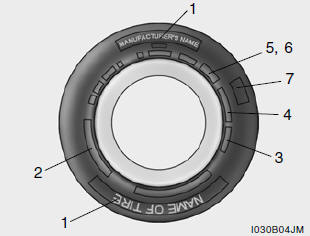Tire Sidewall Labeling

Federal law requires tire manufacturers to place standardized information on the sidewall of all tires. This information identifies and describes the fundamental characteristics of the tire and also provides the tire identification number (TIN) for safety standard certification. The TIN can be used to identify the tire in case of a recall.
1. Manufacturer or Brand name
o Manufacturer or Brand name is shown.
2. Tire size (example: P175/70R14)
o The "P" indicates the tire is designed for passenger vehicles. A "T" is the designation for a temporary spare tire.
o Three-digit number (175): This number gives the width in millimeters of the tire from sidewall edge to sidewall edge.
o Two-digit number (70): This number, known as the aspect ratio, gives the tire's ratio of height to width.
o R: The "R" stands for radial.
o Two-digit number (14): This number is the wheel or rim diameter in inches.
o Two (or three) digit number (84): This number is the tire's load index. It is a measurement of how much weight each tire can support.
o T: Speed Rating. The speed rating denotes the speed at which a tire is designed to be driven for extended periods of time. The ratings range from "A" to "Z" (98 to 186 MPH).
3. TIN (Tire Identification Number) for new tire (example: DOT XX XX XXX XXXX)
o DOT: Abbreviation for the "Department of Transportation". The symbol can be placed above, below or to the left or right of the Tire Identification Number. Indicates tire is in compliance with the U.S. Department of Transportation Motor Vehicle Safety Standards.
o 1st two-digit code: Manufacturer's identification mark o 2nd two-digit code: Tire size o 3rd three-digit code: Tire type code (Optional) o 4th four-digit code: Date of Manufacture o Four numbers represent the week and year the tire was built. For example, the numbers 3109 means the 31st week of 2009.
4. Tire ply composition and material
The number of layers or plies of rubbercoated fabric in the tire. Tire manufacturers also must indicate the materials in the tire, which include steel, nylon, polyester, and others. The letter "R" means radial ply construction; the letter "D" means diagonal or bias ply construction; and the letter "B" means belted-bias ply construction.
5. Maximum permissible inflation pressure
This number is the greatest amount of air pressure that should be put in the tire. Do not exceed the maximum permissible inflation pressure. Refer to the Tire and Loading Information label for recommended inflation pressure.
6. Maximum load rating
This number indicates the maximum load in kilograms and pounds that can be carried by the tire. When replacing the tires on the vehicle, always use a tire that has the same load rating as the factory installed tire.
7. Uniform Tire Quality Grading (UTQG):
Tire manufacturers are required to grade tires based on three performance factors: treadwear, traction and temperature resistance. For more information, see Uniform Tire Quality Grading on page 8-15.
See also:
CARE OF SEAT BELTS
Seat belt systems should never be disassembled or modified. In addition, care
should be taken to assure that seat belts and belt hardware are not damaged by seat
hinges, doors or other abuse.
WAR ...
Removing and storing the spare tire
Turn the tire hold-down wing bolt counterclockwise.
Store the tire in the reverse order of removal.
To prevent the spare tire and tools from “rattling” while the vehicle is in motion,
store them ...
Sunvisor
Use the sunvisor to shield direct light through the front or side windows. To
use a sunvisor, pull it downward. To use a sunvisor for a side window, pull it downward,
unsnap it from the bracke ...


